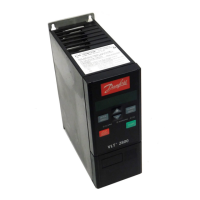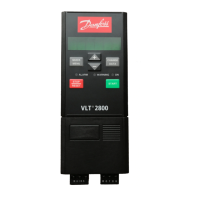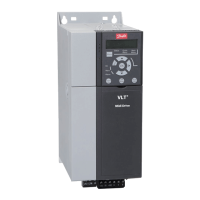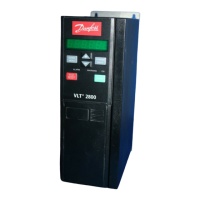Function:
It is possible to set a limit for the differentiator gain. The
differentiator gain will increase if there are fast
changes, which is why it can be beneficial to limit this
gain. Thereby a pure differentiator gain is obtained at
slow changes and a constant differentiator gain where
quick changes to the deviation occur.
Description of choice:
Select a differentiator gain limit as required.
444 Process PID lowpass filter time
(proc filter time)
Value:
0.02 - 10.00
0.02
Function:
Noise in the feedback signal is dampened by a first
order lowpass filter to reduce the noise's impact on the
process regulation. This can be an advantage e.g. if
there is a lot of noise on the signal.
Description of choice:
Select the required time constant (t). If a time constant
(t) of 0.1 s is programmed, the cut-off frequency for the
lowpass filter will be 1/0.1 = 10 RAD/sec., correspond-
ing to (10 / 2 x ) = 1.6 Hz. The process regulator will
thus only regulate a feedback signal that varies by a
frequency lower than 1.6 Hz. If the feedback signal
varies by a higher frequency than 1.6 Hz, it will be
dampened by the lowpass filter.
445 Flying start
(flyingstart)
Value:
Off (DISABLE) [0]
OK - same direction
(OK-same direction) [1]
OK - both directions
(OK-both directions) [2]
DC brake and start
(DC-BRAKE BEF. START) [3]
Function:
This function makes it possible to 'catch' a rotating
motor shaft, which is no longer controlled by the ad-
justable frequency drive, e.g. because of a mains drop-
out. The function is activated each time a start
command is enabled. For the adjustable frequency
drive to be able to 'catch' the rotating motor shaft, the
motor speed must be lower than the frequency that
corresponds to the frequency in parameter 202 Output
frequency, high limit, f
MAX
.
Description of choice:
Select Disable [0] if this function is not required.
Select OK - same direction [1] if the motor shaft is only
able to rotate in the same direction when cutting in. OK
- same direction [1] should be selected if in parameter
200 Output frequency range a selection has been of
Clockwise only .
Select OK - both directions [2] if the motor is able to
rotate in both directions when cutting in.
Select DC brake and start [3] if the adjustable frequen-
cy drive is to be able to brake the motor using the DC
brake first, followed by start. It is assumed that param-
eters 126-127/132 DC brake are enabled. In the case
of higher 'Windmilling' (rotating motor) effects, the ad-
justable frequency drive is not able to 'catch' a rotating
motor without selecting DC brake and start .
Limitations:
-
Too low inertia will lead to load acceleration,
which can be dangerous or prevent correct
catching of a rotating motor. Use the DC
brake instead.
-
If the load is driven, e.g. by 'Windmilling' (ro-
tating motor) effects, the unit may cut out
because of overvoltage.
-
Flying start does not work at lower values
than 250 rpm.
451 Speed PID feedforward factor
(feedforward fact)
Value:
0 - 500 %
100 %
VLT
®
2800 Series
= factory setting, () = display text, [] = value for use in communication via serial communication port
76 MG.27.A2.22 - VLT
®
is a registered Danfoss trademark

